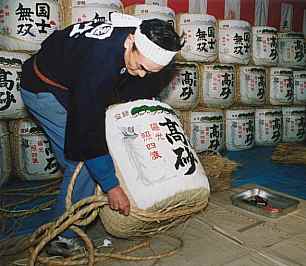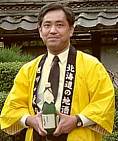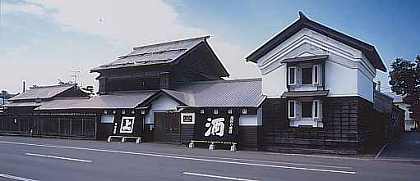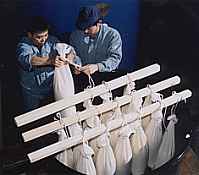|
 
Kura History
Takasago Shuzo was originally established in 1899
in Asahikawa City in Hokkaido, under the name Kohiyama Shuzo (our family name). We struggled, but continued to produce sake during the war. In 1965, we merged with another sake brewer in Asahikawa, and changed our
company name, as well as the name of our sake, to Takasago. Our white-walled kura, built in 1909, is one of the more attractive buildings in Asahikawa (see below).
Asahikawa has been called "the Nada of the north," because there was at one time a lot of sake being brewed there, and we are the oldest sakagura in the area. It is cold here, with the temperature regularly
falling to -20C. Needless to say, the snow is relentless in the winter. It is a wonderful environment in which to brew sake. We proceed bearing in
mind the three principles set forth by our founder almost a century ago: The customer is number one, continue to try and make better and better sake, and always be learning.
The Sake
Our sake is, simply put, dry and balanced. Most of what we brew is light, with a flavor that spreads well across the palate. Approximately 63% of what we make is tokutei meishoushu (special designation) sake, which
means it is "good" stuff. Of that 63%, 12% is ginjo-shu (premium sake). We would rather make quality than quantity.
The People
 (Photo Left: Successor and Senior Managing Director Kohiyama Shunsuke) (Photo Left: Successor and Senior Managing Director Kohiyama Shunsuke)
Our current president, Toru Kohiyama, is the third
-generation kuramoto. About five years ago, he came to a great realization that led to a great decision. He realized that it would no longer be possible to compete with the large brewers from
Nada and Fushimi when it came to selling standard sake. Their sake was simply too cheap, even here in Hokkaido.
"When I realized that it was a battle we could not win, I decided that we
would focus on making good, craft sake, with a local flavor, much like Wagashi (Japanese sweets). I felt that this would help us survive, compete, and thrive.
 |
Size and Special Characteristics
We brew about 4800 koku a year, which amounts to 900 kiloliters or so. Among that, the ration of special designation sake and ginjo-shu is
higher than most sakagura in Japan. While this volume is comparatively higher than many smaller breweries, it is certainly still a relatively small amount. This allows us to maintain our high brewing standards.
Notable Quotes
 Each year, after the temperature drops below -10C, we build an Ice Dome outside near the main kura building. The Ice Dome is basically an igloo inside of which the temperature
stays about -2C or so. It is in this Ice Dome that we make our daiginjo sake, which we call Ichiya Shizuku. The low temperature means nasty bacteria cannot survive, and allows us to make clean, pure, super premium
sake. Each year, after the temperature drops below -10C, we build an Ice Dome outside near the main kura building. The Ice Dome is basically an igloo inside of which the temperature
stays about -2C or so. It is in this Ice Dome that we make our daiginjo sake, which we call Ichiya Shizuku. The low temperature means nasty bacteria cannot survive, and allows us to make clean, pure, super premium
sake.
The name Ichiya Shizuku means "drip overnight," which is precisely how we press the sake, that is, how we separate the clear sake from the
fermenting rice lees. The moromi mash is put into canvas bags, and the sake is allowed to drip out slowly overnight, with no pressure at all applied to the mash. While this may seem wasteful, it creates the most
wonderful, light and clear sake possible.
 Toji (Master Brewer) and Kurabito Toji (Master Brewer) and Kurabito
(Photo: Toji Tokujiro Sasaki)
Our toji, Tokujiro Sasaki, is 69 and going strong. He is of the Nanbu school of toji, centered in Iwate Prefecture. Helping him are 13 others, all of them skilled sake
-brewing veterans. Year after year, cold day after cold day, they labor together at their craft to make our sake what it is.
Contact Info
17 Miyashita-dori, Asahikawa-shi, Hokkaido
 070-0030, Tel 81-166-23-2251 Fax 81-166-22-0973 070-0030, Tel 81-166-23-2251 Fax 81-166-22-0973
-- 81 is Japan country code; within Japan, dial 0166-23-2251 --
Email info@takasago-sake.co.jp
Web: www.takasago-sake.co.jp (J)
|